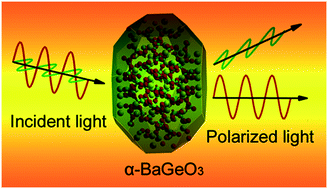Refractive properties of the α-BaGeO3 crystal and their origins: a density functional theory study†
Abstract
Birefringent crystals are often applied to manipulate polarized states of light, yet the birefringent crystals used in the important mid-IR region are scarce. α-BaGeO3 is a potential mid-IR birefringent crystal due to its high mid-IR transmittance and strong structural anisotropy. Here, on the basis of density functional theory (DFT) calculations, we report the refractive characteristics of α-BaGeO3. The crystal is a positive biaxial crystal with the optical principal axes x, y and z parallel to the crystallographic b axis, 2.5° off the a axis, and 19.3° off the c axis, respectively. In the mid-IR region, the principle refractive indices nx, ny and nz are about 1.6297, 1.6308, and 1.6848, respectively. The maximum birefringence is about 0.055 which emerges when a light beam propagates along the x axis. These results indicate that the α-BaGeO3 crystal is a promising birefringent crystal used in the mid-IR region. Interestingly, α-BaGeO3 is quite similar to a uniaxial crystal in refractive characteristics, which is due to its unique layer structure. The refractive characteristics of α-BaGeO3 are associated with the Ba–O bonds; their spatial orientations determine the optical anisotropy of the crystal.



 Please wait while we load your content...
Please wait while we load your content...